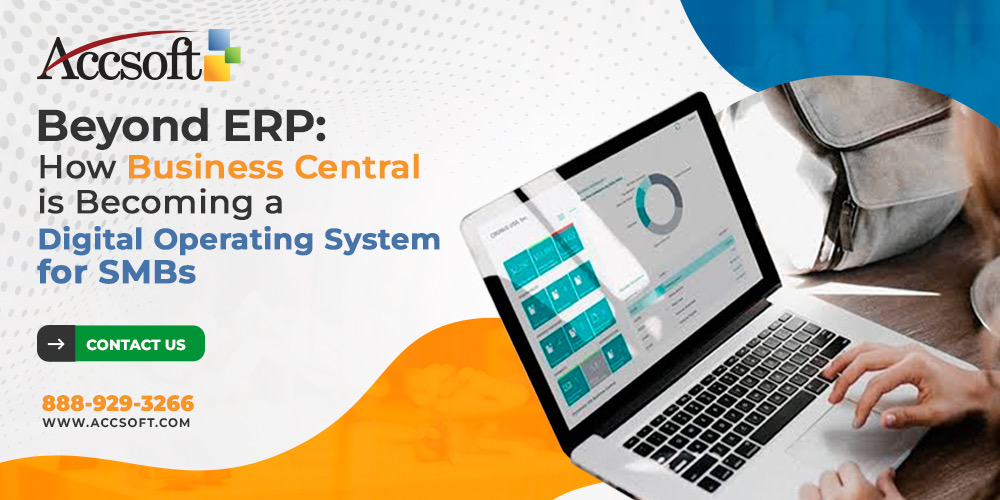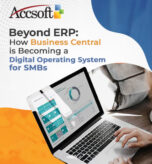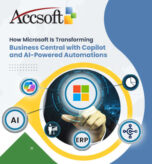
Historically, an “ERP” (Enterprise Resource Planning) system was typically purchased as a monolithic, back-office machine: finance, inventory, HR, maybe procurement. But in today’s hyper-connected, high-speed economy, small and medium-sized businesses (SMBs) demand more, a digital “operating system” that coordinates everything: strategy, operations, collaboration, analytics, and automation. Microsoft’s Dynamics 365 Business Central is well on its way to being just that, a new, cloud-native, extensible platform that shatters the old ERP mold.
Here’s why and how Business Central is revolutionizing beyond ERP and what it means for SMBs that are willing to transform.
1. Why “Beyond ERP” Is Required for SMBs
The limitations of traditional ERPs include:
Siloed modules and rigid upgrades
Traditional apps have isolated modules that don’t talk well to each other or demand heavy customization. Upgrades are painful, costly, and disruptive.
Weak integration with productivity tools
Most traditional ERPs lack native integration with ubiquitous applications like Outlook, Excel, or team collaboration software, compelling users to switch contexts.
Lack of intelligence and automation
Without AI-driven insights or automated functions, SMBs struggle with manual reconciliation, forecasting, and real-time decisions.
Scaling boundaries
As the business grows, legacy ERP environments will hit performance, licensing, or architectural boundaries, requiring expensive rebuilds or rip and replace situations.
2. Business Central as a Digital Operating System
As a digital OS, Business Central excels in several essential areas:
2.1 End-to-end data and workflows across domains
Business Central consolidates finance, supply chain, sales, service, projects, and operations into a single data model. No more isolated ledgers or spreadsheet extracts.
This common ground lets businesses:
- Start workflows between functions (e.g., sales → procurement → delivery)
- Have a “single source of truth”
- Make data consistent and governed
2.2 Deep integration with the Microsoft ecosystem
One of the strong points of Business Central is its built-in, out-of-the-box experience with Microsoft 365 (Outlook, Excel, Teams) and Power Platform (Power BI, Power Automate, Power Apps).
That is to say:
- Users can act upon Business Central information from within Outlook or Teams
- Reports and dashboards can be published into Power BI, with minimal ETL overhead
- Workflows can cross systems, e.g. sending notifications or approvals through Power Automate
2.3 Continuous innovation, modular extensibility and AppSource
Instead of massive version jumps, Business Central is continuously enhanced with Microsoft cloud updates. SMBs are not stuck in clunky upgrade cycles.
In the meantime, its architecture enables partners and ISVs to build apps and extensions (via Microsoft AppSource) that tailor the system for verticals or niche needs.
Thus, Business Central can grow with the business or evolve as new processes become required, a key attribute of a digital OS.
2.4 Embedded intelligence and automation
Business Central is infused with AI, machine learning, and “agent” abilities (e.g. via Copilot) to assist with decision-making, forecasting, and process automation.
Examples include:
- Issuing alerts when stock dips too low
- Forecasting cash flow or demand
- Automating banking reconciliation
- Implying action or exceptions for review rather than full manual control
This shifts the system from passive “record keeper” to active “advisor.”
2.5 Role-based access, workflow, and governance
A business OS needs to enable users without compromising the system. Business Central provides:
- Role-based dashboards and permissions
- In-built workflow engines for approvals
- Audit trails, compliance features, and in-built security
- Multicompany, multi-currency, multi-lingual capabilities for expansion beyond borders
2.6 Elastic scalability and cloud-first architecture
Because Business Central is cloud-native (or hybrid), it scales elastically with usage, no more worrying if you’ve outgrown your system.
3. Pillars of the Business Central Operating System
Below are the underlying layers supporting this digital OS positioning:
| Pillar | Description | SMB Value |
|---|---|---|
| Core Transactions and Data Model | Multi-ledger, inventory, orders, projects, service, etc. | Eliminates data silos; ensures consistency |
| Integration Layer / APIs | Speaks to external systems (e.g. payroll, e-commerce, CRM). | Extensibility, interoperability |
| Workflow and Process Engine | Business process definitions, automations, approvals | Business process alignment and automation |
| Analytics and Intelligence | Predictive models, dashboards, AI agents | Real-time insights, predictions, actionable triggers |
| UI and Experience Layer | Role-based dashboards, mobile/desktop UI | Usability, productivity |
| Security / Governance / Compliance | Access controls, audit logs, data policies | Peace of mind, regulatory alignment |
| App Ecosystem / Extensions | Marketplace add-ons and vertical modules | Adapts to sophisticated or specialty needs |
With those layers, Business Central feels more like a living platform than a stuck ERP.
4. Why SMBs Are Embracing Business Central in This Era
4.1 Agility and adaptability
Business circumstances change quickly. SMBs need systems that keep up, not systems that put on rigid rework. Business Central facilitates incremental update, configuration alteration, and low-code adjustment.
4.2 Cost efficiency and total cost of ownership (TCO)
Cloud deployment frees users from infrastructure overhead, patching, and hardware refresh cost. Forrester-sponsored research shows strong ROI in migrating to Business Central.
4.3 Faster implementation and onboarding
Unlike monolithic legacy ERPs, Business Central can be deployed in phases. Modularity, guided setup, and role-tailored dashboards make time-to-value faster.
4.4 Future readiness and continuous updates
The cloud model ensures that SMBs are on a platform under constant enhancement, with the newest features, instead of being stuck on old versions.
4.5 Unified ecosystem and lower friction
Because many SMBs already use Microsoft 365, Business Central is just an extension, not an added system. That simplifies adoption.
4.6 Reducing the risks of retaining legacy ERPs
Being on outdated systems is risky: performance caps, compliance gaps, inability to expand, and increasing maintenance burden.
5. Conclusion: A New Era for SMB Digital Infrastructure
By 2025 and beyond, SMBs don’t just need an ERP, they need a digital operating platform that unifies operations, intelligence, collaboration, and agility. Business Central is morphing into just that, more than a transactional engine, it’s becoming the digital “hub” of SMBs’ strategy, execution, and innovation.
For SMB leaders, the inquiry now is no longer “Will we buy an ERP?” but rather “Which platform will really drive our business end to end?” Business Central is positioning itself as the answer, a platform that scales, adapts, and empowers without the disruption and rigidity of traditional systems.







